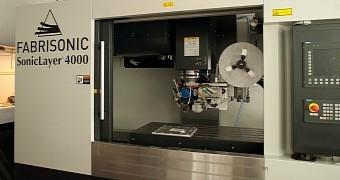Normally, in order to create anything out of metal via additive manufacturing, you need to use an SLS 3D printer. Selective laser sintering, whereby a metal powder is fused together into an object by subjecting it to a strong laser ray.
There are other ways, but they are either closely related like SLM (selective laser melting) or still in prototype stage of development.
One of those prototype techniques may have finally become a legitimate threat to the “exclusivity” of SLS in the metal 3D printing space. The technology we are talking about is Ultrasonic Additive Manufacturing, or UAM for short.
A company by the name of Fabrisonic has begun to produce parts for aicraft, cars, research, and industrial applications.
The UAM process and how it works
Whereas SLM and SLS use metal powders, UAM instead employs layers of metal foil. The foils can be made of copper, aluminum, stainless steel or titanium.
The ultrasound is capable of combining the sheets of metal together in real metallurgical bonds, thus giving rise to new and sophisticated metals that are also very strong.
Frequencies of around 20,000 hertz are utilized, causing metal foils to weld together so long as the layers themselves are subjected to sufficient pressure.
The ultrasonic welding process can keep adding height to an object by simply adding more metal foil layers.
This goes for both “pure” metals and combinations, like successive layers of aluminum and steel, or copper and aluminum, or any other mix.
All in all, UAM is a very fine application of the ultrasonic welding process that has been in use since the 1960s.
The Fabrisonic 3D printing technology works in all three dimensions (all sides can be machined) and, thus, can be used to make very sophisticated objects and flow paths. See the SonicLayer 7200 demo in the video for more.
The advantages
Ultrasound printing can yield superior heat exchanger devices thanks to the complexity of the passages exceeding that of any CNC-milled alternative. Complex internal geometries are no longer hit and miss.
Most importantly, UAM can include embedded electronics. You can literally grow an object with internal circuits and chips and whatever else.
There is just one pitfall: UAM doesn't allow for the same freedom that other 3D methods do, and it needs CNC milling to be done for each metal layer. Still, even as a complementary technology, it has great potential.

 14 DAY TRIAL //
14 DAY TRIAL // 